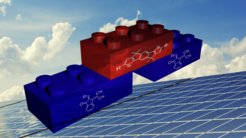Building-block solar cells
Computer algorithm searches for new materials for organic solar cells
Organic, carbon-based, materials already see widespread use in displays today, but they are also promising materials for new solar cells. However, tailoring their properties is time-consuming and requires extensive chemical synthesis and characterization. A new simulation protocol has now been developed at the Max Planck Institute for Polymer Research that combines already known molecular building blocks to form new structures and correlates them with the solar cell efficiency and could thus significantly simplify development processes.
Organic solar cells could serve a key role in the transition towards renewable energies. However, a cheap synthetic route and a high cell efficiency are instrumental in aiding this transition. The discovery of a new material class, known as “non-fullerene acceptors”, provides a cost-efficient synthetic route as compared to the more traditional silicon solar cells, while providing a higher efficiency than the first organic solar cells.

The design of these “non-fullerene acceptor” materials with properties tailored for the use in solar cells still poses challenges. A new simulation-based design methodology to simplify this procedure has now been developed in the group of Denis Andrienko, department of Kurt Kremer at the Max Planck Institute for Polymer Research, and colleagues. The design methodology makes use of already known organic solar cells with high efficiencies by dividing them into several building blocks. These fragments are made up of either electron-donating or electron-accepting molecular components, so-called "acceptors" and "donors". Donor and acceptor building blocks from different known solar cells can be combined to give new “non-fullerene acceptor” molecules for the use in solar cells.
"It is a challenge to select the right one from the large number of existing molecular compounds - that is why we use our method to access already existing solar cells and combine their molecular components to create new solar cells," says Kun-Han Lin, a co-author of the study.
The design algorithm includes constraints that reduce the number of possible “non-fullerene acceptor” molecules – such as molecular symmetry, quadrupole moment, ionization energy and electron affinity. For example, in cases where an acceptor-donor-acceptor combination is used the two acceptor building blocks are always of the same type.
This design methodology is already showing promise and helps to predict solar cell efficiency before materials are actually synthesized.
“We were thrilled when we realized that our method worked: out of 12 predicted efficient solar cells, 10 have already been produced, and are highly efficient," Andrienko said.
They have published their work in the renowned journal "Advanced Energy Materials".












